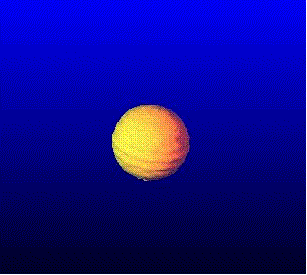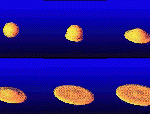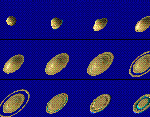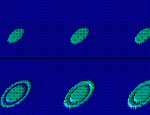 Spray forming processes have received increased attention in the field of materials manufacturing because of their inherent flexibility and because they generate significant energy and cost savings. A major concern, however, is the porosity of the resulting materials. The research effort described herein focuses on the numerical investigation of the deformation, interaction and solidification during substrate impact of molten droplets in spray processing.
Spray forming processes have received increased attention in the field of materials manufacturing because of their inherent flexibility and because they generate significant energy and cost savings. A major concern, however, is the porosity of the resulting materials. The research effort described herein focuses on the numerical investigation of the deformation, interaction and solidification during substrate impact of molten droplets in spray processing.
The deformation and spreading of fully liquid droplets as they impact onto a flat or non-flat substrate was considered first. This analysis was then extended to include multiple droplet interaction at impact, and also to account for solidification. Emphasis of the on-going work is on the description of micro-pore formation and the evaluation of the resulting porosity.
Downloadable Publications
- Delplanque, J.-P., E. J. Lavernia, and Rangel, R.H., “Simulation of micro-pore formation in spray deposition processes,” Accepted for presentation at the 1996 ASME IMECE, Second International Symposium on Multiphase Flows and Heat Transfer in Materials Processing, Atlanta, GA, November 17-22, 1996.
- Delplanque, J.-P., E. J. Lavernia, and Rangel, R.H., “Multi-Directional Solidification Model for the Description of Micro-Pore Formation in Spray Deposition Processes,” Numerical Heat Transfer, Part A, 30, 1-18, 1996.
- Liu, H., Lavernia, E. J., and Rangel, R. H., “Modeling of Molten Droplet Impingement on a Non-Flat Surface”, Acta Metallurgica et Materialia, 43, 5, pp:2053-2072, 1995.
- Liu, H., Lavernia, E. J., and Rangel, R. H., “Numerical Investigation of Micro-Pore Formation During Substrate Impact of Molten Droplets in Plasma Spray Processes”, Atomization and Sprays, 4, pp:369-384, 1994.
- San Marchi, C., Liu, H., Lavernia, E.J., and Rangel, R.H., “Numerical Analysis of the Deformation and Solidification of a Single Droplet Impinging onto a Flat Substrate”, Journal Of Materials Science, 28, pp:3313-3321, 1993
- Liu, H., Lavernia, E. J., and Rangel, R. H., “Numerical Simulation of Impingement of Molten Ti, Ni, and W Droplet on a Flat Substrate”, Journal of Thermal Spray Technology, 2, 4, pp:369-378, 1993.
- Liu, H., Lavernia, E. J., and Rangel, R. H., “Numerical Simulation of Substrate Impact and Freezing of Droplets in Plasma Spray Processes”, J. Phys. D: Appl. Phys., 26, pp:1900-1908, 1993.
Numerical Investigation
A code called RIPPLE (NASA/Los Alamos) is used to simulate the free surface flow dynamics. The velocity field inside the deforming liquid droplet is computed as a solution of the incompressible Navier-Stokes equations. A Volume of Fluid function is defined in order to track the location of the free-surface.
RIPPLE was modified to include the solidification process. A locally one-dimensional solid front advances from the substrate toward the free surface. Currently, an improved model which allows for two-dimensional growth of the solid front is being developed.
Accurate description of the pore formation mechanism requires a sub-micronic mesh in both axial and radial directions. Since computations start at the time of impact, the computation domain must extend axially to include the complete incident drop. Furthermore, the resulting splat radial size is typically one order of magnitude larger than the initial droplet radius. Another constraint arises from the need for higher accuracy in the evaluation of surface tension forces which exponentiate at break-up, thus drastically limiting the magnitude of the maximum time step. Note that a proper computation of break-up is pivotal in the determination of porosity.
Deformation and Spreading of Fully Liquid Droplets
 The calculated results reveal that non-solidifying Ti, Ni, and W droplets impinging on a flat substrate spread uniformly in the radial direction and eventually form thin splats with final diameters and thicknesses up to 11.3 times and down to 0.02 times the impact diameter, respectively. The final splat diameter increases rapidly with increasing impact velocity and melt density or decreasing melt viscosity. These computations showed that the flattening behavior is controlled by inertia and viscous effects and yielded correlations for the final splat diameter and the spreading time with the Reynolds number.
The calculated results reveal that non-solidifying Ti, Ni, and W droplets impinging on a flat substrate spread uniformly in the radial direction and eventually form thin splats with final diameters and thicknesses up to 11.3 times and down to 0.02 times the impact diameter, respectively. The final splat diameter increases rapidly with increasing impact velocity and melt density or decreasing melt viscosity. These computations showed that the flattening behavior is controlled by inertia and viscous effects and yielded correlations for the final splat diameter and the spreading time with the Reynolds number.
Non-flat Substrate Case
Simulations of fully liquid droplet impact on a non-flat substrate showed that, in this case, the flattening behavior is also controlled by an additional normal stress introduced by the curved surface. Two mechanisms controlling the spreading process were identified. If the radial surface roughness is greater than the initial droplet diameter, periodic acceleration-decelerations are observed, eventually leading to violent breakup. Whereas cases with radial surface roughness smaller than the initial droplet diameter exhibit sheer hindering of the spreading process. Larger impact velocities, larger roughness height or smaller radial roughness result in earlier occurrence of the violent breakup. therefore, decreasing the roughness height or increasing the radial roughness improves flattening.
Multiple Droplet Interaction
If a fully liquid droplet impinging onto a flat substrate leads to good contact between the splat and the substrate, multiple fully liquid droplets striking simultaneously onto other flattening, fully liquid splats cause ejection and rebounding of the liquid, as well as formation of voids within the liquid. A combination of a liquid droplet condition at high initial velocity with a semi-solid or solid surface condition may produce good adhesion in sprayed deposits or coatings.
Solidification
When solidification is included, Tungsten droplets are found to spread and solidify into splats with diameters 1.6 to 3.8 times the initial droplet diameter within a time of 0.12 to 0.44 micro-s.
Micro-Pore Formation
Preliminary results regarding micropore formation lead to the description of one mechanism. At impact, the liquid in contact with the substrate starts to solidify thus forming a solid layer. The high velocity liquid flowing on top of this layer then detaches in a manner akin to that observed in liquid-jet overflow. The liquid layer reattaches to the substrate leaving a gap between the solidified layer’s edge and the reattachment point where solidification also starts. Finally, multidirectional solidification may freeze this liquid bridge thus forming a micropore underneath.


